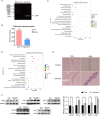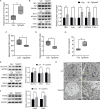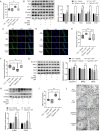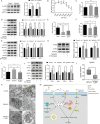Iron-overload-induced ferroptosis in mouse cerebral toxoplasmosis promotes brain injury and could be inhibited by Deferiprone
- PMID: 37651502
- PMCID: PMC10508604
- DOI: 10.1371/journal.pntd.0011607
Iron-overload-induced ferroptosis in mouse cerebral toxoplasmosis promotes brain injury and could be inhibited by Deferiprone
Abstract
Iron is a trace metal element that is essential for the survival of cells and parasites. The role of iron in cerebral toxoplasmosis (CT) is still unclear. Deferiprone (DFP) is the orally active iron chelator that binds iron in a molar ratio of 3:1 (ligand:iron) and promotes urinary iron excretion to remove excess iron from the body. The aims of this experiment were to observe the alterations in iron in brains with Toxoplasma gondii (T. gondii) acute infections and to investigate the mechanism of ferroptosis in CT using DFP. We established a cerebral toxoplasmosis model in vivo using TgCtwh3, the dominant strains of which are prevalent in China, and treated the mice with DFP at a dose of 75 mg/kg/d. Meanwhile, we treated the HT-22 cells with 100 μM DFP for half an hour and then infected cells with TgCtwh3 in vitro. A qRT-PCR assay of TgSAG1 levels showed a response to the T. gondii burden. We used inductively coupled plasma mass spectrometry, an iron ion assay kit, Western blot analysis, glutathione and glutathione disulfide assay kits, a malonaldehyde assay kit, and immunofluorescence to detect the ferroptosis-related indexes in the mouse hippocampus and HT-22 cells. The inflammatory factors interferon-γ, tumor necrosis factor-α, transforming growth factor-β, and arginase 1 in the hippocampus and cells were detected using the Western blot assay. Hematoxylin and eosin staining, electron microscopy, and the Morris water maze experiment were used to evaluate the brain injuries of the mice. The results showed that TgCtwh3 infection is followed by the activation of ferroptosis-related signaling pathways and hippocampal pathological damage in mice. The use of DFP led to ferroptosis resistance and attenuated pathological changes, inflammatory reactions and T. gondii burden of the mice, prolonging their survival time. The HT-22 cells with TgCtwh3 activated the ferroptosis pathway and was inhibit by DFP in vitro. In TgCtwh3-infected cells, inflammatory response and mitochondrial damage were severe, but these effects could be reduced by DFP. Our study elucidates the mechanism by which T. gondii interferes with the host's iron metabolism and activates ferroptosis, complementing the pathogenic mechanism of CT and further demonstrating the potential value of DFP for the treatment of CT.
Copyright: © 2023 Wang et al. This is an open access article distributed under the terms of the Creative Commons Attribution License, which permits unrestricted use, distribution, and reproduction in any medium, provided the original author and source are credited.
Conflict of interest statement
The authors have declared that no competing interests exist.
Figures





References
-
- Szewczyk-Golec K, Pawlowska M, Wesolowski R, Wroblewski M, Mila-Kierzenkowska C. Oxidative Stress as a Possible Target in the Treatment of Toxoplasmosis: Perspectives and Ambiguities. Int J Mol Sci. 2021;22(11):5705. Epub 2021/06/03. doi: 10.3390/ijms22115705 ; PubMed Central PMCID: PMC8198901. - DOI - PMC - PubMed
Publication types
MeSH terms
Substances
LinkOut - more resources
Full Text Sources
Research Materials

